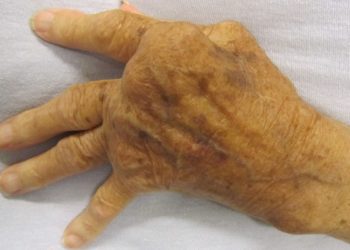#VisualAbstract: Half of patients hospitalized with COVID-19 continue to have symptoms after 1 year
1. The proportion of patients with one or more symptom sequelae significantly decreased from 6 months (68%) to 12 months (49%).
2. 88% of patients had returned to employment within 12 months of hospital discharge.
Evidence Rating Level: 2 (Good)
Study Rundown: Although COVID-19-related hospitalization is common, little is known about the long-term complications among COVID-19 survivors. One study suggests that discharged patients have persisting symptoms at 6 months, contributing to a poor health-related quality of life. However, there has been a lack of studies reporting on outcomes after 12 months. This longitudinal cohort study aimed to 1) assess the 6- and 12-month health outcomes of patients hospitalized for COVID-19 and 2) compare their 12-month health status to non-COVID-19 patients. The primary outcomes for this study were patient-reported symptoms, modified British Medical Research Council (mMRC) score, health-related quality of life (HRQOL) and 6-minute walking distance (6MWD), while secondary outcomes included lung function, hospitalization after discharge, and employment status at 6 and 12 months. According to results, steady recovery was noted among COVID-19 survivors at the 12-month period, with most returning to baseline activity levels. In addition, the proportion of patients with one or more symptom sequelae was significantly lower in the 12-month follow-up than at 6-months. A major limitation of this study is that it did not stratify results by age. This is important since physical and functional recovery may vary based on patients’ age and comorbidities.
Click to read the study in The Lancet
Relevant Reading: Four-Month Clinical Status of a Cohort of Patients After Hospitalization for COVID-19
In-depth [retrospective cohort]: Between Jan 7 and May 29, 2020, 2469 patients were discharged from the Jan Yin-tan hospital after recovering from COVID-19 in Wuhan, China. Only 52% (n=1276) completed both the 6- and 12-month follow-up and were included in the final analysis. Median age among patients was 59.0 years (interquartile range [IQR] 49.0-67.0) and the majority (53%, n=681) were male.
The primary outcome of at least one sequelae symptom was significantly higher at 6 months than at 12 months (68% vs. 49%, p<0.0001). However, the opposite was true for mMRC-based dyspnea (26% at 6 months vs. 30% at 12 months, p=0.014) and HRQOL, with more patients having anxiety or depression at the 12-month follow-up (26%) than at the 6-month follow-up (23%, p=0.015). The proportion of patients with 6MWD below the lower limit of normal was slightly greater at 6 months (14%) than at 12 months (12%, p=0.033). Regarding key secondary outcomes, lung function did not differ from 6 to 12 months (p>0.05), with impairment found in 23% of patients in severity scale 3 and 54% of patients in scale 5-6 at 12-months. Healthcare use within one year of discharge from the hospital was limited, with 18% patients accessing outpatient clinics, 13% reporting re-hospitalization, and 1% reporting a visit to the emergency department. Finally, majority of patients (88%) returned to work within 12 months of discharge. Overall, COVID-19 survivors had good health trajectory and functional recovery at 12 months after hospitalization. However, it may be beneficial to continue to monitor these patients for lasting complications past the 12-month timepoint.
Image: PD
©2021 2 Minute Medicine, Inc. All rights reserved. No works may be reproduced without expressed written consent from 2 Minute Medicine, Inc. Inquire about licensing here. No article should be construed as medical advice and is not intended as such by the authors or by 2 Minute Medicine, Inc.









